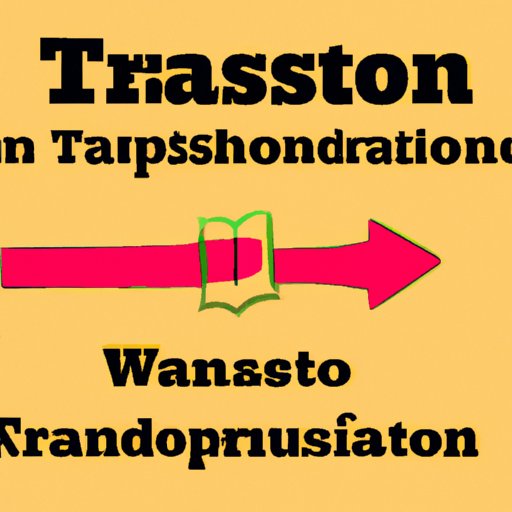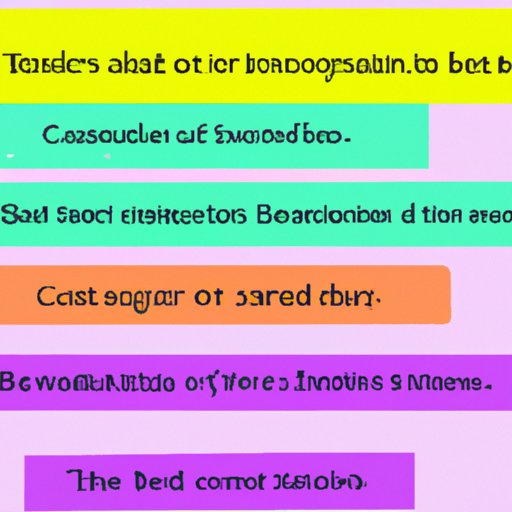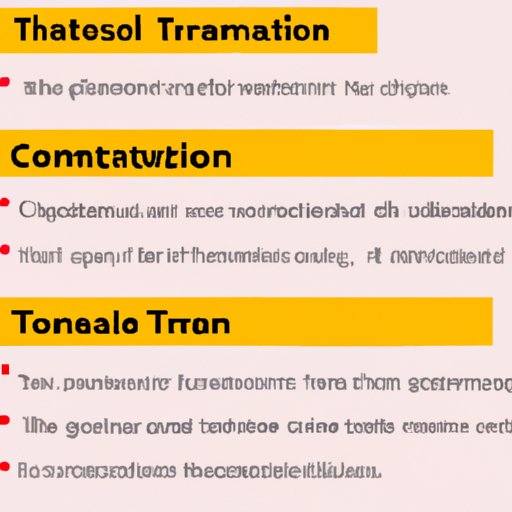Introduction
Writing can be challenging. It requires the right language, structure, and style to convey your message effectively. One of the most important tools at your disposal is transition words in writing. But what are transition words, and how can they help you make your writing more impactful? This article explores what transition words are, how to use them effectively, and offers examples from both academic and creative writing.
Exploring the Different Types of Transition Words in Writing
Transitional words are phrases or words used to connect one idea to the next. They help to create cohesion and structure in writing. Transitions can be used to show a contrast, signal a cause-effect relationship, or add emphasis. There are many different types of transitional words and phrases, each serving a specific purpose.
Definition of Transitional Words
Transitional words are words or phrases that help create logical connections between ideas in your writing. They help to make your writing more cohesive and provide readers with smooth transitions between sentences and paragraphs. By using transitional words and phrases, you can make it easier for your reader to understand your message and follow your train of thought.
Categories of Transitional Words
Transitional words can be divided into several categories based on their purpose. These categories include words and phrases that show addition, contrast, comparison, time, place, and cause and effect relationships. Other categories of transition words include those that emphasize a point, indicate an example, and provide clarification or restatement.

How to Use Transition Words Effectively in Your Writing
Using transition words effectively in your writing can help to make your work more coherent and structured. Here are some tips for making the most of transition words in your writing.
Understanding Context and Meaning
When using transition words, it’s important to understand the context and meaning behind them. For example, a transition word like “however” may indicate a contrast between two ideas, while a word like “therefore” may be used to indicate a cause-effect relationship. Understanding the context and meaning of transition words will help you to choose the right ones for your writing.
Creating Flow and Coherence
Transition words can help to create flow and coherence in your writing. By using them strategically, you can ensure that your ideas are presented logically and clearly. This will make your writing more compelling and engaging for your readers.
Avoiding Repetition
It’s also important to avoid repeating the same transition words over and over again. Doing so can make your writing seem monotonous and dull. Instead, try to vary the transition words you use and aim to use them in different ways throughout your writing.
The Power of Transition Words: What Makes Them So Effective?
Transition words are powerful tools in writing. They can help to create relationships between ideas, strengthen arguments, and add emphasis to certain points. Let’s take a look at some of the ways that transition words can make your writing more effective.
Showing Relationships between Ideas
Transition words can be used to show relationships between ideas. For example, the words “in contrast” or “on the other hand” can be used to show a contrast between two ideas. Similarly, phrases like “in addition” and “moreover” can be used to show a connection between two ideas.
Strengthening Arguments
Transitions can also be used to strengthen arguments. The words “for instance” and “specifically” can be used to provide examples that support a particular point. Likewise, words like “thus” and “consequently” can be used to draw conclusions from previous statements.
Adding Emphasis
Finally, transition words can be used to add emphasis to certain points. Phrases like “indeed” and “without a doubt” can be used to emphasize a point or argument. Similarly, words like “clearly” and “obviously” can be used to draw attention to a particular point.
A Comprehensive Guide to Transition Words and Their Usage
Now that we’ve explored what transition words are and how to use them effectively, let’s take a look at a comprehensive guide to transition words and their usage. This guide includes a list of common transition words and phrases, as well as examples of how to use them in your writing.
List of Common Transitional Words and Phrases
Here is a list of some of the most common transition words and phrases:
- Moreover
- However
- Therefore
- In addition
- Similarly
- Nevertheless
- On the other hand
- For instance
- Specifically
- Thus
- Consequently
- Indeed
- Without a doubt
- Clearly
- Obviously
Examples of Usage
Here are some examples of how to use these transition words in your writing:
- “Moreover, the study found that…”
- “However, there is still much work to be done.”
- “Therefore, we can conclude that…”
- “In addition, this research has implications for…”
- “Similarly, the results of this experiment suggest that…”
- “Nevertheless, further research is needed.”
- “On the other hand, this data paints a different picture.”
- “For instance, this study found that…”
- “Specifically, these findings demonstrate that…”
- “Thus, we can see that…”
- “Consequently, this has led to…”
- “Indeed, this is a significant problem.”
- “Without a doubt, this is an important issue.”
- “Clearly, this is an urgent matter.”
- “Obviously, this needs to be addressed.”

Crafting Cohesive Sentences with Transition Words
Once you have a list of transition words and phrases, you can start to incorporate them into your writing. Here are some tips for crafting cohesive sentences with transition words.
Constructing Paragraphs with Transitions
When constructing paragraphs, it’s important to think about how to link your ideas together. Using transition words can help to create a logical flow between sentences and paragraphs. This will make it easier for your reader to understand your message and follow your train of thought.
Using Connectives for Smooth Transitions
Connectives are words or phrases that link ideas together. They can be used to create smooth transitions between sentences and paragraphs. Examples of connectives include words like “besides,” “furthermore,” and “in conclusion.” Using connectives in your writing will help to make your ideas flow more naturally and create a better overall structure.

Examples of How to Incorporate Transition Words into Your Writing
Now that we’ve explored how to use transition words effectively, let’s take a look at some examples of how to incorporate them into your writing.
Examples from Academic Writing
Here are some examples of how to use transition words in academic writing:
- “Furthermore, this study revealed…”
- “In addition, the data suggests…”
- “Nevertheless, this hypothesis was disproven.”
- “Therefore, we can conclude that…”
- “On the other hand, this theory has been refuted.”
- “Specifically, this research indicates that…”
- “Thus, these findings suggest that…”
- “Consequently, this has led to…”
Examples from Creative Writing
Here are some examples of how to use transition words in creative writing:
- “Moreover, he felt a deep sense of guilt.”
- “However, she refused to give up hope.”
- “In addition, the storm clouds were gathering.”
- “Nevertheless, he chose to remain optimistic.”
- “On the other hand, she had lost all faith.”
- “For instance, the world seemed darker than ever.”
- “Specifically, he saw no way out of his despair.”
- “Thus, he decided to take matters into his own hands.”
- “Consequently, things would never be the same again.”
Conclusion
Transition words are powerful tools in writing. They can help to create relationships between ideas, strengthen arguments, and add emphasis to certain points. This article explored what transition words are, how to use them effectively, and offered examples from both academic and creative writing. By understanding the purpose of transition words and incorporating them into your writing, you can make your work more engaging and compelling for your readers.
(Note: Is this article not meeting your expectations? Do you have knowledge or insights to share? Unlock new opportunities and expand your reach by joining our authors team. Click Registration to join us and share your expertise with our readers.)
